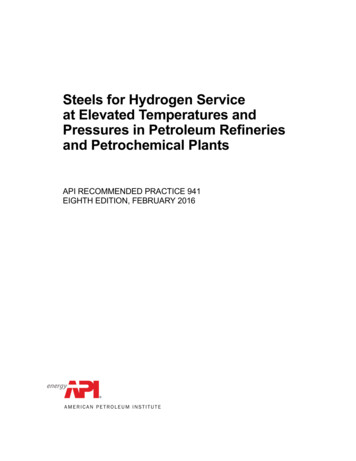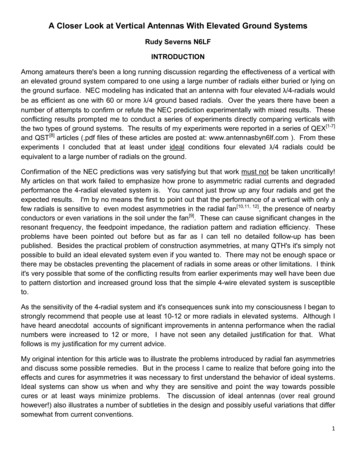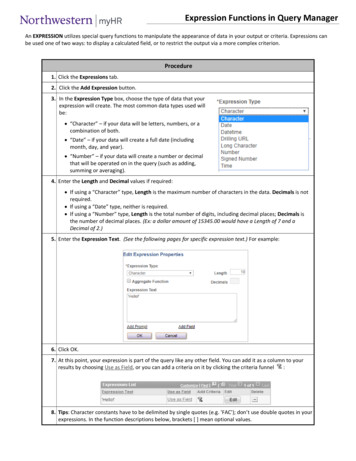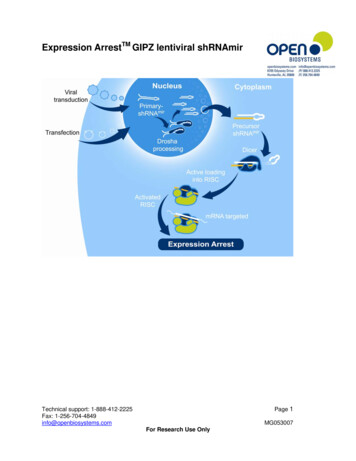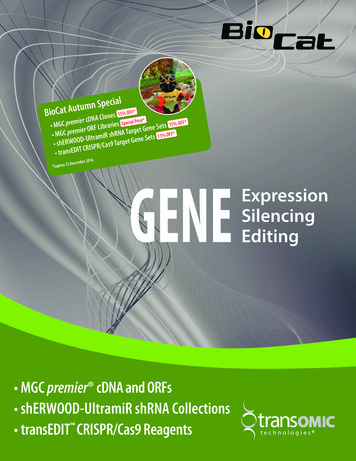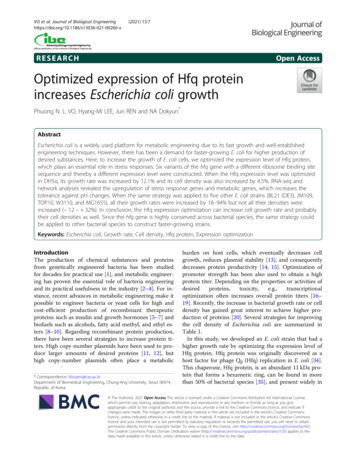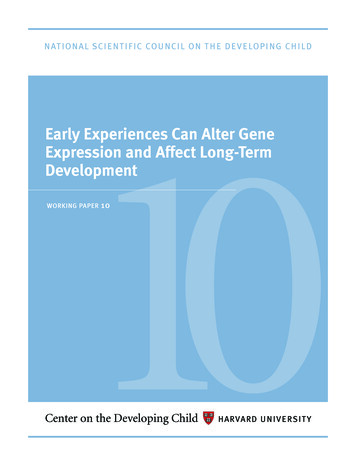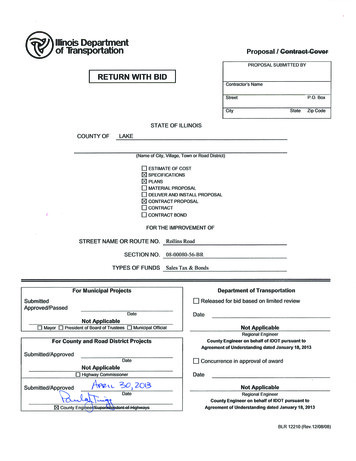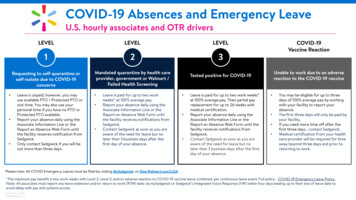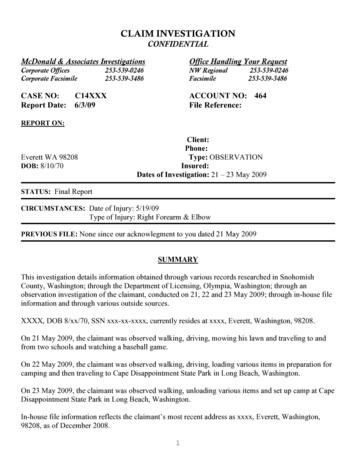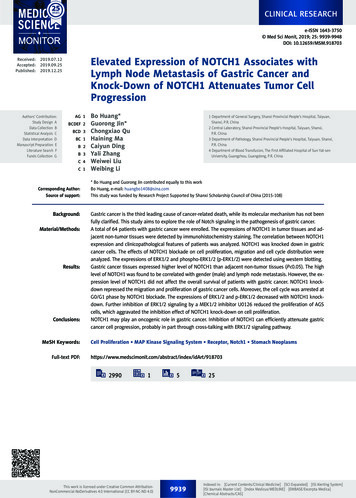
Transcription
CLINICAL RESEARCHe-ISSN 1643-3750 Med Sci Monit, 2019; 25: 9939-9948DOI: vated Expression of NOTCH1 Associates withLymph Node Metastasis of Gastric Cancer andKnock-Down of NOTCH1 Attenuates Tumor rs’ Contribution:Study Design AData Collection BStatistical Analysis CData Interpretation DManuscript Preparation ELiterature Search FFunds Collection GAG 1BCDEF 2BCD 3BC 1B 2B 3C 4C 1Corresponding Author:Source of sions:MeSH Keywords:Full-text PDF:Bo Huang*Guorong Jin*Chongxiao QuHaining MaCaiyun DingYali ZhangWeiwei LiuWeibing Li1 Department of General Surgery, Shanxi Provincial People’s Hospital, Taiyuan,Shanxi, P.R. China2 Central Laboratory, Shanxi Provincial People’s Hospital, Taiyuan, Shanxi,P.R. China3 Department of Pathology, Shanxi Provincial People’s Hospital, Taiyuan, Shanxi,P.R. China4 Department of Blood Transfusion, The First Affiliated Hospital of Sun Yat-senUniversity, Guangzhou, Guangdong, P.R. China* Bo Huang and Guorong Jin contributed equally to this workBo Huang, e-mail: huangbo1408@sina.comThis study was funded by Research Project Supported by Shanxi Scholarship Council of China (2015-108)Gastric cancer is the third leading cause of cancer-related death, while its molecular mechanism has not beenfully clarified. This study aims to explore the role of Notch signaling in the pathogenesis of gastric cancer.A total of 64 patients with gastric cancer were enrolled. The expressions of NOTCH1 in tumor tissues and adjacent non-tumor tissues were detected by immunohistochemistry staining. The correlation between NOTCH1expression and clinicopathological features of patients was analyzed. NOTCH1 was knocked down in gastriccancer cells. The effects of NOTCH1 blockade on cell proliferation, migration and cell cycle distribution wereanalyzed. The expressions of ERK1/2 and phospho-ERK1/2 (p-ERK1/2) were detected using western blotting.Gastric cancer tissues expressed higher level of NOTCH1 than adjacent non-tumor tissues (P 0.05). The highlevel of NOTCH1 was found to be correlated with gender (male) and lymph node metastasis. However, the expression level of NOTCH1 did not affect the overall survival of patients with gastric cancer. NOTCH1 knockdown repressed the migration and proliferation of gastric cancer cells. Moreover, the cell cycle was arrested atG0/G1 phase by NOTCH1 blockade. The expressions of ERK1/2 and p-ERK1/2 decreased with NOTCH1 knockdown. Further inhibition of ERK1/2 signaling by a MEK1/2 inhibitor U0126 reduced the proliferation of AGScells, which aggravated the inhibition effect of NOTCH1 knock-down on cell proliferation.NOTCH1 may play an oncogenic role in gastric cancer. Inhibition of NOTCH1 can efficiently attenuate gastriccancer cell progression, probably in part through cross-talking with ERK1/2 signaling pathway.Cell Proliferation MAP Kinase Signaling System Receptor, Notch1 Stomach x/idArt/91870329901This work is licensed under Creative Common AttributionNonCommercial-NoDerivatives 4.0 International (CC BY-NC-ND 4.0)5993925Indexed in: [Current Contents/Clinical Medicine] [SCI Expanded] [ISI Alerting System][ISI Journals Master List] [Index Medicus/MEDLINE] [EMBASE/Excerpta Medica][Chemical Abstracts/CAS]
Huang B. et al.:Expression and knock-down of NOTCH1 in gastric cancer Med Sci Monit, 2019; 25: 9939-9948CLINICAL RESEARCHBackgroundMaterial and MethodsGastric cancer is prevalent worldwide; it ranks the third causeof death from cancer [1]. East Asia shows the highest incidencerate of gastric cancer. In China, gastric cancer ranks the second cause of cancer death among both men and women [2].Surgical excision is currently the effective treatment for gastriccancer. However, the outcomes are poor in metastatic gastriccancer, with median survival being about 1 year [3]. Therefore,it is necessary to investigate the molecular mechanism of andto find novel therapeutic strategies for gastric cancer.Patients and tissue specimensNotch signaling is evolutionarily conserved. It is involved incell proliferation, migration, differentiation, apoptosis, determination of cell fate, and other cellular processes [4]. In mammals, Notch signaling has 4 receptors (Notch1/2/3/4) and 5ligands (delta-like ligand (DLL) 1/3/4, and jagged 1/2). Notchsignaling has been found to be involved in tumorigenesis andis highly context dependent. It can be an oncogene as well asa tumor suppressor gene, depending on cellular context [5].For example, it plays an oncogenic role in colorectal cancer [6]and breast cancer [7], whereas it plays a tumor-suppressiverole in squamous cell carcinoma [8].Activation of Notch signaling was found to be critically involvedin gastric cancer development [9,10]. Activated NOTCH1 wasfound to be a poor indicator of overall prognosis of gastric tumors [11]. High expression levels of NOTCH1-4 was correlatedwith an unfavorable rate of survival for 876 gastric cancer patients [12]. Also, elevated expression of NOTCH1 was correlated with Lauren classification, tumor invasion, lymph nodemetastasis, and differentiation of gastric cancer [13]. Thesefindings suggested an oncogenic role of NOTCH1 in gastriccancer. However, other studies demonstrated a tumor-suppressive role of NOTCH1. Zhou et al. found that NOTCH1 hadlower expression in gastric cancer tissues than in paired nontumor tissues [14]. Bauer et al. demonstrated that increasedNOTCH1 level was associated with a good prognosis of gastric cancer, indicating an anti-tumor role of NOTCH1 [15]. Thus,the function of Notch signaling in gastric cancer is still controversial and the regulatory mechanisms involved need to befurther investigated.In the present study, we tried to reveal the exact role of Notchsignaling on gastric cancer progression. We first detected theexpression profile of NOTCH1 in gastric tumor tissues and contiguous non-tumor tissues; and then knocked down NOTCH1in vitro to explore the effect of Notch signaling on the biological process of human gastric cancer cells.This work is licensed under Creative Common AttributionNonCommercial-NoDerivatives 4.0 International (CC BY-NC-ND 4.0)Samples of both gastric cancer tissue and nearby normal tissue were collected from 64 patients with gastric cancer whoreceived a gastrectomy between July 2015 and January 2016 atthe Department of General Surgery, Shanxi Provincial People’sHospital (Shanxi, China). The study included 47 males and 17females with a mean age of 61.7 9.3 years. None of the patients had received chemotherapy or radiotherapy prior to thesurgery. All tissue samples were formalin-fixed and paraffinembedded (FFPE) and were confirmed by pathological diagnosis. Clinicopathological features of all patients were collected (Table 1). All patients were followed up until April 2019.This study was complied with the approved guidelines of theHuman Research Ethics Committee of Shanxi Provincial People’sHospital and informed consent was obtained from all patients.Immunohistochemistry (IHC) stainingSections were cut from the FFPE blocks and mounted on silanized slides. The slides were baked at 65 C for 2 hours, thenthe paraffin wax was removed with xylene before dehydrationwith graded ethanol. In order to retrieve the antigens, the slideswere boiled in citric acid buffer for 20 minutes. After coolingand washing, the slides were blocked with 5% bovine serumalbumin (BSA) for 10 minutes at room temperature. The slideswere then incubated with rabbit anti-human NOTCH1 monoclonal antibody (1: 100; ab52627, Abcam, Cambridge, MA, USA)overnight at 4 C. Phosphate-buffered saline (PBS) instead ofthe primary antibody was used in the negative control. Afterwashing with PBS, the slides were incubated with secondaryantibody (Boster Biological Technology, Wuhan, China) for1 hour and subsequently stained with DAB.The expression of NOTCH1 was blindly assessed by 2 experienced pathologists using high-power light microscopy (200 ).The pathologists scored both the staining intensity and the ratioof positive cells. Staining intensity was scored on a 0 to 3 scale:0 (negative), 1 (weak), 2 (moderate), and 3 (intense). The percentage of positive cells was quantified as 0 was 5%), 1 was5–25%, 2 was 26–50%, 3 was 51–75%, and 4 as 76–100%.Multiplying the intensity score by the percentage score resultedin the final staining score. The final scores were then gradedinto 4 groups: (–) a final score of 0, ( ) staining final scorebetween 1 and 4, ( ) staining final score between 5 and 8,( ) staining final score between 9 and 12. For Pearson’sc2 analysis, the final score was grouped into negative (finalscore, 0) or positive (final score, 1–12).9940Indexed in: [Current Contents/Clinical Medicine] [SCI Expanded] [ISI Alerting System][ISI Journals Master List] [Index Medicus/MEDLINE] [EMBASE/Excerpta Medica][Chemical Abstracts/CAS]
Huang B. et al.:Expression and knock-down of NOTCH1 in gastric cancer Med Sci Monit, 2019; 25: 9939-9948CLINICAL RESEARCHTable 1. Clinicopathological features of patients with gastric cancer.Clinicopathological FeaturesNOTCH1Negative (%)Positive (%)P 8) 6015(55.6)12(44.4) Poor13(52.0)12(48.0)Moderate and well17(45.9)20(54.1)0(0.0)0.000Age (years)0.235Tumor invasion0.850Lymph node metastasis0.007Distant metastasis0.365TNM staging0.384DifferentiationOtherCell culture and stable cell lines establishmentAn AGS cell line, derived from human gastric carcinoma, wasobtained from the Cell Bank of Chinese Academy of Sciences(Shanghai, China). The AGS cells were cultured in F-12K medium (Sigma-Aldrich, St Louis, USA) containing 10% fetal bovine serum (FBS) (Gibco, New York, USA) at 37 C in a 5% CO2atmosphere.Three GIPZ lentiviral vectors targeting human NOTCH1 (shN1-1,shN1-2, shN1-3), one GIPZ lentiviral control vector (Vec),packaging plasmid psPAX2, and envelope expressing plasmid pMD2.G were generously provided by Dr. HuangxuanShen (Zhongshan Ophthalmic Center, Sun Yat-sen University,Guangzhou, China). Stable AGS cell lines with NOTCH1 knockdown were established using the lentivirus system. The GIPZlentiviral vectors combined with psPAX2 and pMD2.G weretransfected into 293T cells using the Effectene TransfectionReagent (Qiagen, Valencia, CA, USA). AGS cells were plated at50–70% confluence in 6-well plates and were subsequentlyThis work is licensed under Creative Common AttributionNonCommercial-NoDerivatives 4.0 International (CC BY-NC-ND 4.0)0.3602 (100.0)infected with 2 mL medium with a virus containing 8 µg/mLpolybrene (Sigma-Aldrich, St Louis, MO, USA) for 24 hours.Finally, the AGS cells were screened using 1 µg/mL puromycin(Sigma-Aldrich, St Louis, MO, USA) for 48 hours.Western blottingTotal protein was extracted from control cells and NOTCH1knock-down cells. The western blotting procedures were aspreviously described [16]. The primary antibodies used wereas following: rabbit anti-human NOTCH1 monoclonal antibody (1: 1000; ab52627, Abcam, Cambridge, MA, USA), rabbitanti-human ERK1/2 polyclonal antibody (1: 500; D151753,Sangon Biotech, Shanghai, China), and rabbit anti-humanphospho-ERK1/2 polyclonal antibody (1: 500; D151384, SangonBiotech, Shanghai, China). Mouse anti-human GAPDH monoclonal antibody (1: 500; BM1623, Boster Biological TechnologyWuhan, China) was used as a loading control.9941Indexed in: [Current Contents/Clinical Medicine] [SCI Expanded] [ISI Alerting System][ISI Journals Master List] [Index Medicus/MEDLINE] [EMBASE/Excerpta Medica][Chemical Abstracts/CAS]
Huang B. et al.:Expression and knock-down of NOTCH1 in gastric cancer Med Sci Monit, 2019; 25: 9939-9948CLINICAL RESEARCHEdU assay and Cell Counting Kit-8 (CCK-8) assayStatistical analysesA Cell-Light EdU DNA cell proliferation kit (RiboBio, Guangzhou,China) was utilized to quantify proliferation of AGS cells.The cells were then incubated with grown medium supplemented with 10 μM EdU for 2 hours at 37 C. Following incubation, AGS cells were washed twice using PBS, and fixedin 4% paraformaldehyde (PFA). The cells were permeabilizedwith 0.5% Triton-X-100 followed by 30 minutes of incubation with Apollo staining solution and then 30 minutes withHoechst 33342. Photographs were captured with a fluorescent microscope (Nikon Corporation, Tokyo, Japan). The quantity of EdU positive cells and Hoeschst 33342 positive cellswere determined by NIS-Elements BR Imaging Software (NikonCorporation, Tokyo, Japan).Three repetitions of each experiment were performed in order to improve accuracy of data. Statistical analyses were carried out using SPSS version 20.0 (Chicago, IL, USA). The datawere described as mean standard deviation. The correlationbetween NOTCH1 expression and clinicopathological featureswas determined by Pearson’s c2 test. The significance of differences for comparisons between groups was determined using Student t-test. Overall survival curves stratified by NOTCH1expression were estimated by Kaplan-Meier analyses, and thesignificance was calculated with log-rank test. A P value of 0.05 was considered statistically significant.The proliferation of AGS cells was further studied by a CCK-8assay. Briefly, plated the cells into 96-well plates and treatedcells with none, DMSO, 10 µM U0126 (Medchem Express,Shanghai, China), 20 µM U0126 for 0 hours, 24 hours, and48 hours. The proliferation rate was tested using a commercial CCK-8 kit (Dojindo, Shanghai, China). Cells were incubatedwith 10 µL of the CCK-8 reagent at 37 C for 2 hours. An absorbance reading of 450 nm was obtained using a Synergy 4 Multi–Mode Reader (BioTek, Winooski, VT, USA).Scratch assayAGS cells were plated in 6-well plates in growth medium toreach a confluence. At time 0, a 200 µL pipette tip was usedto create a scratch wound, and then the cells were washedand cultured in medium with 2% FBS. Cells that migratedinto the scratch area were observed and images were takenwith a microscope (Nikon Corporation, Tokyo, Japan) after24 hours and 48 hours. ImageJ software (National Institutesof Health, Bethesda, MD, USA) was used to quantify changesin scratch area.Cell cycle analysisEffect of NOTCH1 knock-down on the cell cycle progressionwas analyzed using Cell Cycle Detection Kit (KeyGEN BioTECH,Jiangsu, China) by flow cytometry. Control cells and NOTCH1knock-down cells were fixed in 70% ethanol and incubated at4 C for at least 4 hours. The cells were stained with propidiumiodide (PI) containing RNase A after collection, then incubatedfor 60 minutes in the dark. The fraction of cells at differentcell-cycle phases was determined using an FC500 flow cytometer (Coulter, Beckman, Palo Alto, CA, USA).ResultsThe expression of NOTCH1 increased in gastric cancerImmunohistochemistry (IHC) staining was utilized to detectNOTCH1 expression in gastric tumor and contiguous non-tumortissues from patients with gastric cancer. The IHC staininglevels of NOTCH1 was graded as (–), ( ), ( ), and ( ) according to the IHC scores (Figure 1A–1D). The proportion ofNOTCH1-positive tissues (IHC , , or ) in gastric cancertissues was 53.1% (n 34); which was strongly higher that incontiguous non-tumor tissues (14.1%, n 9). Additionally, comparison between the IHC score of the 2 groups showed a significant difference (P 0.01) (Figure 1E).The clinical significance of NOTCH1 expression in gastriccancerIn order to assess the clinical significance of NOTCH1 expression in gastric cancer, we explored the correlation betweenNOTCH1 expression and clinicopathological characteristics inpatients with gastric cancer through Pearson’s c2 test. The results showed that the elevated expression of NOTCH1 stronglycorrelated with gender (male, P 0.000) and lymph node metastasis (P 0.007) (Table 1). However, the high expression ofNOTCH1 showed no correlation with depth of invasion, TNMstaging, differentiation and other clinicopathological features.We further evaluated the prognostic value of NOTCH1 expression in gastric cancer by Kaplan-Meier analysis. No statistically significant difference in overall survival was observed between NOTCH1-positive and NOTCH1-negative groups (P 0.55)(Figure 1F).NOTCH1 knock-down suppressed cell proliferationWe established stable AGS cell lines with NOTCH1 knockdown using 3 shRNAs targeting NOTCH1 (shN1-1, shN1-2,and shN1-3). Western blot analysis was utilized to determineThis work is licensed under Creative Common AttributionNonCommercial-NoDerivatives 4.0 International (CC BY-NC-ND 4.0)9942Indexed in: [Current Contents/Clinical Medicine] [SCI Expanded] [ISI Alerting System][ISI Journals Master List] [Index Medicus/MEDLINE] [EMBASE/Excerpta Medica][Chemical Abstracts/CAS]
Huang B. et al.:Expression and knock-down of NOTCH1 in gastric cancer Med Sci Monit, 2019; 25: 9939-9948ACLINICAL RESEARCHBECP 0.0115FNOTCH1 positiveNOTCH1 nehgtive100Overall survival (%)10HCS scoreD5050P 0.550–5Gastric tumorn 64Adjacent non-tumorn 640102030Time (months)4050Figure 1. Immunohistochemistry (IHC) staining of NOTCH1 in gastric cancer tissues. The NOTCH1 protein expression in gastric cancertissues was examined by IHC staining. (A–D) Representative images of IHC staining, denoting (–), ( ), ( ), and ( ) staininglevel of NOTCH1 in gastric cancer tissues, respectively. Images were taken at magnification of 200 . (E) IHC score of NOTCH1were compared between gastric tumor and adjacent non-tumor tissues. (F) Overall survival curves for patients with gastriccancer stratified by NOTCH1 expression.the knock-down efficiency of NOTCH1 (Figure 2A). The shN1-1showed a minimal inhibition rate, while shN1-3 showed thehighest inhibition rate.EdU assay was utilized to detect the effect of NOTCH1 knockdown on AGS cell growth. The proportion of EdU positive cellsin the NOTCH1 knock-down cells, especially in shN1-2 cells, wasless than that in the control cells (Vec group); however, thisdifference showed no statistically significance (Figure 2B, 2C).Notably, the shN1-3 cells, which showed the highest NOTCH1inhibition rate, did not show the least EdU positive cells.CCK-8 assay was utilized to further detect the function ofNOTCH1 knock-down on cell growth. The results showed thatNOTCH1 knock-down (shN1-1, shN1-2, shN1-3) suppressedcell growth significantly in AGS cells (P 0.01) (Figure 2D).At 72 hours, the proliferation rate of shN1-2 cells was inhibited at utmost. However, shN1-3 showed the lowest inhibitionrate. These results indicated that NOTCH1 knock-down inhibited cell proliferation in gastric cancer in vitro, which was notin a dose-dependent manner.cells demonstrated high capability of migration consideringthe scratch wound had reached almost full recovery after48 hours of incubation. At 24 hours, significantly fewer cells inthe shN1-2 and shN1-3 groups compared to the control cellshad migrated into the scratch area. At 48 hours, a statisticallysignificant decrease in scratch area reduction was found in allof the 3 groups with NOTCH1 knock-down (P 0.01) (Figure 3B).The data indicated that downregulation of NOTCH1 effectivelyinhibited the migratory ability of AGS cells.Inhibition of NOTCH1 caused G0/G1 cell cycle arrestSince inhibition of NOTCH1 suppressed AGS cell growth, we further investigated the cell cycle distribution of AGS cells with orwithout NOTCH1 knock-down using flow cytometry. We foundthat AGS cells accumulated in the G0/G1 phase when NOTCH1was knocked down (Figures 4A–4D). The percentage of cellsin G0/G1 phase in Vec cells was 49.94 8.72%, while that inshN1-2 and shN1-3 cells were 72.47 3.82% and 70.72 3.27%,respectively (P 0.05) (Figure 4E).NOTCH1 knock-down inhibited cell migrationERK1/2 signaling participates in the NOTCH1 knock-downmediated repression o
Received: 2019.07.12 Accepted: 2019.09.25 Published: 2019.12.25 2990 1 5 25 Elevated Expression of NOTCH1 As
